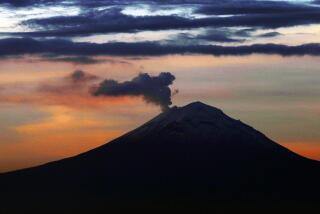Scientists Having Heyday Chronicling ‘Child of Krakatau’
- Share via
KRAKATAU, Indonesia — Scientists are braving sulfurous fumes, storms of boulders and waves of lava-generated heat to get a peek at a newborn volcano, the offspring of the most violent volcanic eruption in recorded history.
More than a century after the Krakatau volcano--also known in the West as Krakatoa--ripped apart in a blast 26 times more powerful than the greatest hydrogen bomb test explosion, scientists are having a heyday chronicling every hiss of steam and belch of gas as its successor builds anew.
“It’s a unique natural laboratory,” said American volcanologist Thomas Casadevall over the roar rippling across the lunar-like landscape, “an opportunity to record the evolution of a volcano.”
Rising in the Sunda Strait between the islands of Sumatra and Java is the legacy of Krakatau, a rapidly growing and restless youngster aptly named Anak Krakatau, Indonesian for “Child of Krakatau.”
Latest Eruption
Its latest eruption, ending six years of quiet, has lured scientists anxious for a close-up look at a young volcano growing at the same spot as Krakatoa and the fledgling rain forest on its northeast coast.
The now 600-foot-high cone also beckons hardy tourists, undaunted by the four-hour boat ride from the west Java shoreline or the steep climb up the volcanic flanks for a glimpse of the pillar of steam and smoke and sporadic bursts of fiery lava and showers of boulders and ash.
Scientists say the possibility of another eruption equal to Krakatoa in Aug. 26, 1883, which killed 36,000 people, is unlikely. But nervous Indonesians stay away, and only small, isolated communities dot the bay where bodies drifted in the aftermath of the 1883 explosion.
For scientists like Casadevall, Indonesia is a “dream come true”; it has more active volcanoes than any other country. Of 128 volcanoes, 65 are considered active, meaning they have erupted within the past four centuries and could erupt again.
Role in Modern Studies
“Krakatau helped shape the modern science of volcanology,” said Casadevall, who is based at the Volcanological Survey Institute of Indonesia in a monitoring project partly funded by the U.S. Agency for International Development.
Casadevall, part of the team at the 1980 explosion of Mount St. Helens in Washington, said Krakatau’s detailed historical record “has enormously expanded man’s awareness of volcanic processes.”
Although Krakatau is surrounded by monitoring stations where technicians study seismographs and look for clues that might predict an eruption, there was no advance warning of the March 6 outburst, the first since 1981, Casadevall said. The duration of the eruption is equally elusive.
The 19-hour volcanic explosion of 1883 destroyed 2,683-foot Krakatau, triggering 135-foot tidal waves that wiped out hundreds of villages on neighboring coasts. The waves, racing 350 m.p.h., reached 10 miles inland, destroying everything in their path.
Darkness for 3 Days
Debris blown 25 miles into the sky circled the globe seven times. Dust clouds created darkness for three days within a 310-mile radius.
Ash fell on Singapore, 522 miles north, and on ships sailing more than 3,700 miles away. Months later, floating pumice washed up in Africa.
The roar of the explosions was heard 1,400 miles away, sparking a stampede of sheep in South Australia. The volume of ash, rock and pumice spewed into the air was placed at nearly 20 cubic kilometers. Mount St. Helens disgorged a mere 1 cubic kilometer.
Krakatau simply disappeared. But it wasn’t dead. A new volcanic island began to rise from the sea.
Series of ‘Marine Eruptions’
In the early 1920s, fishermen began reporting bubbles and increasingly warm water over the area where Krakatau had been. Then, as modern volcanologists reconstruct it, came a series of “marine eruptions,” pouring lava onto the ocean floor.
Gradually, Casadevall said, a cone built up on the seabed. Lava spewed from the top, boiling the water around it. The process continued until Anak Krakatau pierced the surface in 1927. Casadevall and his colleagues aren’t guessing how high it will grow.
Volcanologists recorded two strong eruptions on Krakatau Junior in 1952 and 1972, plus many smaller ones.
“It is an eerie kind of world,” said Axel Ridder, owner of the nearest tourist hotel, who was so enraptured by Krakatau’s evolution that he moved from Berlin to Java 18 years ago. “Every time I go out there I am awed and humbled. It is an extraordinary experience.”
More to Read
Sign up for Essential California
The most important California stories and recommendations in your inbox every morning.
You may occasionally receive promotional content from the Los Angeles Times.













